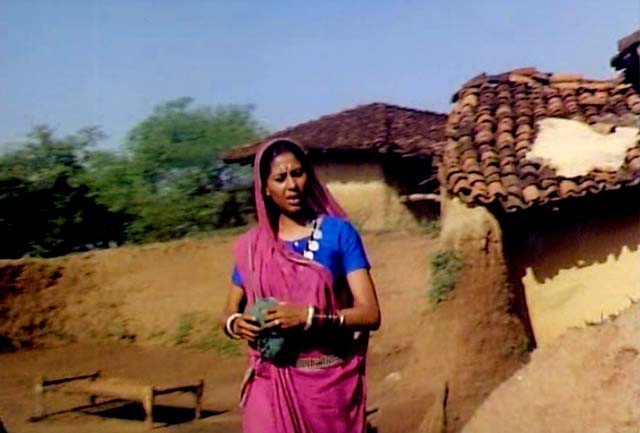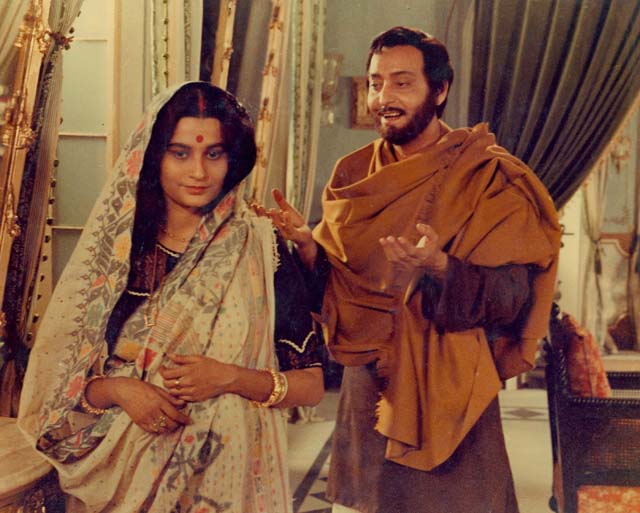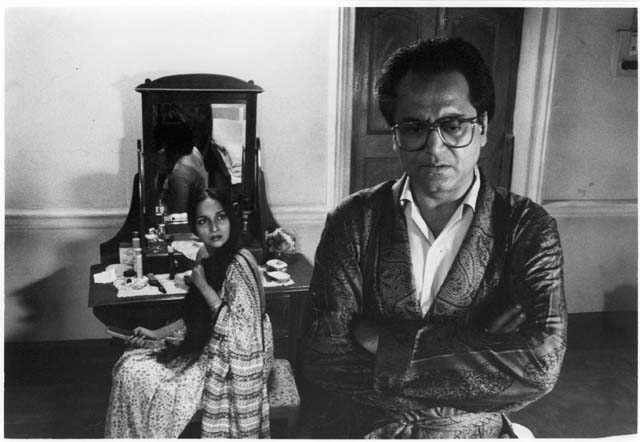
Long Shadows: The Late Work of Satyajit Ray
Dhukia, a poor untouchable, journeys to the home of Ghashiram, the village brahmin, to request him to set an auspicious date for his daughter’s wedding. He is made to wait, told to clean the stables and chop wood. The hapless man, burdened by caste and class, malnourished and starving, labors in silence – finally dying in the scorching sun. For Ghashiram, the death is an inconvenience; the dilemma is how to get rid of the corpse of an untouchable man…
“Deliverance’ (Satgadi) is a powerful short film by Satyajit Ray based on a short story by Munshi Premchand. This stark film underlines the brutishness of life, the inhumanity of man to man, and is one you won’t forget in a hurry.
New Yorkers got to see this film in the recent film series – Long Shadows: the Late Work of Satyajit Ray, at the Walter Reade Theater, organized by the Film Society of Lincoln Center. This series showcased the later works of Ray which have not been screened as frequently as his earlier ones. ‘Deliverance’, with little dialogue and evocative close-ups, has a strong cast of actors – Om Puri, Smita Patil and Mohan Agashe. It’s a film which stays with you, leaving a lot unsaid and a lot to mull over.

Satyajit Ray’s ‘The Home and the World’
The series also showcased ‘The Home and the World’, Ray’s adaptation of the novel by Rabindranath Tagore, whose 150th birth anniversary is being celebrated this year. Another important film was Ray’s last work, ‘The Stranger’ starring Utpal Dutt. The film prints screened at Long Shadows are from the Collection of Satyajit Ray Film and Study Center, University of California, Santa Cruz.
The series which started on April 19 runs through April 26. It includes ‘An Enemy of the People’, based on the Ibsen play and starring Soumitra Chatterjee; ‘Distant Thunder’ (about the Bengal famine of 1943), ‘The Branches of a Tree’, about an ailing patriarch and a family reunion; ‘The Golden Fortress’, ‘The Elephant God’ – both movies about the master detective Feluda; ‘The Kingdom of Diamonds’ about the delightful duo Goupy and Bagha. Also shown was ‘The Chess Players’ set in British India, and ‘Sikkim’, a film rarely shown.
‘The Stranger’ can be seen on April 26 at 2.15 pm,’ Sikkim’ on April 26 at 4.15 pm, and ‘The Branches of a Tree’ on April 26 at 6.10. Below are brief synopses.
‘The Stranger’ – In this disarming, thoughtful coda to Ray’s career, a forgotten uncle (Utpal Dutt) visits his family after decades of wandering, leading to debates over civility and civilization.
‘Sikkim’ – Commissioned by the ruler of a Himalayan state, Ray made this controversial poetic sketch, which was swiftly subjected to censorship. Screening with Bala (1976, India; 33m) Ray’s rarely screened record of the famed Bharata Natyam dancer.
‘The Branches of a Tree’: When a family patriarch falls ill, his grown sons rush in from Calcutta, leading to a reunion filled with painful ironies and lingering disillusionment.
For details on these screenings, check Long Shadows – the Late Work of Satyajit Ray
Satyajit Ray- Master Filmmaker
Already an acknowledged giant of world cinema, Ray in these later works reveals a more meditative side: his brilliant powers of observation lead him to pare down his style, allowing his characters and the world to reveal themselves to us. Satyajit Ray (1921-1992), was born into a family of distinguished printers, writers and artists in Calcutta. At the age of 18, upon his mother’s prodding, he started studies at Rabindranath Tagore’s Vishva-Bharati University in order to become a commercial artist. Ray left the university before graduating and joined an advertising agency, where he would work for 13 years.
An avid film fan since school years, he co-founded Calcutta’s first film society in 1947. Around the same time, Ray started writing film criticism, which appeared in both English and Bengali publications. In 1949, Ray met Jean Renoir, while the French director was scouting locations in India for The River. Renoir encouraged Ray’s passion for cinema; however, an appointment to the London office of the ad agency prevented him from working on Renoir’s film. While in London, Ray saw De Sica’s The Bicycle Thief, which solidified his ideas about making a realistic Indian film, shot in existing locations with a non-professional cast.
A prolific director, Ray made a feature every year from 1956 to 1981. In addition, Ray developed a notable literary career, writing short stories, articles and novels as well as reviving a children’s magazine, Sandesh, started by his grandfather. On March 30, 1992, Satyajit Ray was awarded the Honorary Oscar for lifetime achievement. Due to ill health, he could not attend the ceremony and his acceptance speech was pre-recorded in Calcutta. He died on April 23 that year.
(Source: Film Society of Lincoln Center)
For those of you interested in learning more about the films of Satyajit Ray, The Satyajit Ray Film and Study Center (Ray FASC) is a non-profit educational organization dedicated to the preservation and dissemination of his cinematic, literary and artistic oeuvre. It is organized as a Focused Research Activity in the Humanities Division of the University of California, Santa Cruz.


4 Comments
Swati, even for non-Bengali speakers, the films are such a rich experience. Wish I spoke Bengali to fully enjoy all the nuances.
Thanks for your comments, Kriti. You’re right, you always discover something new when you watch the films again.
Ray is my most favourite film maker in the world even today…if you did understand Bengali, and managed to comprehend the many wonderful films he has made in the language, his films are the ultimate treat….He really was a genius. Thanks for sharing Lavina. Loved your post!
He was really something Lavina. Have watched nearly all his movies several times and have always found a new layer to ponder about. I don’t think there can be another Ray in this world – he was a genius – just one of a kind. Thanks a ton for sharing this wonderful post.